Related Research Articles

Algae are any of a large and diverse group of photosynthetic, eukaryotic organisms. The name is an informal term for a polyphyletic grouping that includes species from multiple distinct clades. Included organisms range from unicellular microalgae, such as Chlorella, Prototheca and the diatoms, to multicellular forms, such as the giant kelp, a large brown alga which may grow up to 50 metres (160 ft) in length. Most are aquatic and lack many of the distinct cell and tissue types, such as stomata, xylem and phloem that are found in land plants. The largest and most complex marine algae are called seaweeds. In contrast, the most complex freshwater forms are the Charophyta, a division of green algae which includes, for example, Spirogyra and stoneworts. Algae that are carried by water are plankton, specifically phytoplankton.
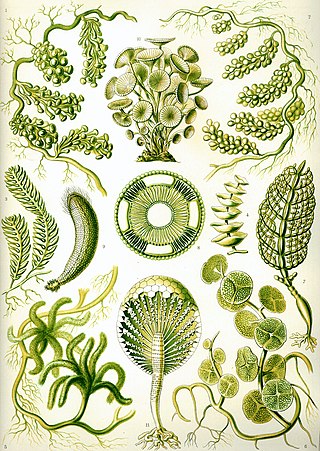
Chlorophyta is a division of green algae informally called chlorophytes.
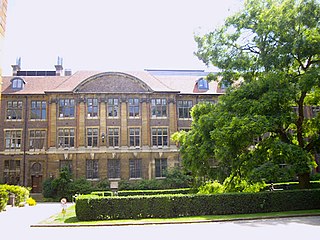
The Department of Plant Sciences is a department of the University of Cambridge that conducts research and teaching in plant sciences. It was established in 1904, although the university has had a professor of botany since 1724.

Chlorella is a genus of about thirteen species of single-celled green algae of the division Chlorophyta. The cells are spherical in shape, about 2 to 10 μm in diameter, and are without flagella. Their chloroplasts contain the green photosynthetic pigments chlorophyll-a and -b. In ideal conditions cells of Chlorella multiply rapidly, requiring only carbon dioxide, water, sunlight, and a small amount of minerals to reproduce.

Microalgae or microphytes are microscopic algae invisible to the naked eye. They are phytoplankton typically found in freshwater and marine systems, living in both the water column and sediment. They are unicellular species which exist individually, or in chains or groups. Depending on the species, their sizes can range from a few micrometers (μm) to a few hundred micrometers. Unlike higher plants, microalgae do not have roots, stems, or leaves. They are specially adapted to an environment dominated by viscous forces.
Don Grierson is a British geneticist, and Emeritus Professor at University of Nottingham.
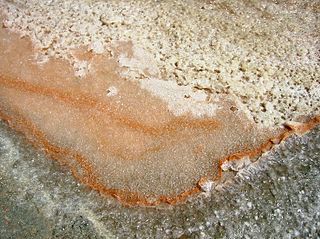
Dunaliella salina is a type of halophile unicellular green algae especially found in hypersaline environments, such as salt lakes and salt evaporation ponds. Known for its antioxidant activity because of its ability to create a large amount of carotenoids, it is responsible for most of the primary production in hypersaline environments worldwide, and is also used in cosmetics and dietary supplements.
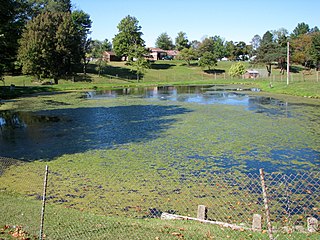
Algal nutrient solutions are made up of a mixture of chemical salts and seawater. Sometimes referred to as "Growth Media", nutrient solutions, provide the materials needed for algae to grow. Nutrient solutions, as opposed to fertilizers, are designed specifically for use in aquatic environments and their composition is much more precise. In a unified system, algal biomass can be collected by utilizing carbon dioxide emanating from power plants and wastewater discharged by both industrial and domestic sources. This approach allows for the concurrent exploitation of the microalgae's capabilities in both carbon dioxide fixation and wastewater treatment. Algae, macroalgae, and microalgae hold promise in addressing critical global challenges. Sustainable development goals can be advanced through algae-based solutions, to promote a healthy global ecosystem.
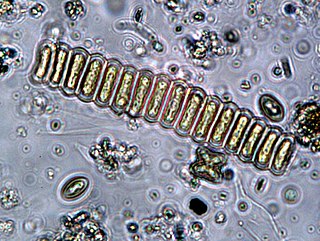
Scenedesmus is a genus of green algae, in the class Chlorophyceae. They are colonial and non-motile. They are one of the most common components of phytoplankton in freshwater habitats worldwide.

Choricystis is a genus of green algae in the class Trebouxiophyceae, considered a characteristic picophytoplankton in freshwater ecosystems. Choricystis, especially the type species Choricystis minor, has been proposed as an effective source of fatty acids for biofuels. Choricystis algacultures have been shown to survive on wastewater. In particular, Choricystis has been proposed as a biological water treatment system for industrial waste produced by the processing of dairy goods.

Algae fuel, algal biofuel, or algal oil is an alternative to liquid fossil fuels that uses algae as its source of energy-rich oils. Also, algae fuels are an alternative to commonly known biofuel sources, such as corn and sugarcane. When made from seaweed (macroalgae) it can be known as seaweed fuel or seaweed oil.

The enzyme sirohydrochlorin ferrochelatase (EC 4.99.1.4) catalyzes the following reaction:

Red algae, or Rhodophyta, make up one of the oldest groups of eukaryotic algae. The Rhodophyta comprises one of the largest phyla of algae, containing over 7,000 recognized species within over 900 genera amidst ongoing taxonomic revisions. The majority of species (6,793) are Florideophyceae, and mostly consist of multicellular, marine algae, including many notable seaweeds. Red algae are abundant in marine habitats. Approximately 5% of red algae species occur in freshwater environments, with greater concentrations in warmer areas. Except for two coastal cave dwelling species in the asexual class Cyanidiophyceae, no terrestrial species exist, which may be due to an evolutionary bottleneck in which the last common ancestor lost about 25% of its core genes and much of its evolutionary plasticity.
Algae fuel in the United States, as with other countries, is under study as a source of biofuel.

Catherine Rosemary Martin is a Professor of Plant Sciences at the University of East Anglia (UEA) and project leader at the John Innes Centre, Norwich, co-ordinating research into the relationship between diet and health and how crops can be fortified to improve diets and address escalating chronic disease globally.

Nigel Shaun Scrutton is a British biochemist and biotechnology innovator known for his work on enzyme catalysis, biophysics and synthetic biology. He is Director of the UK Future Biomanufacturing Research Hub, Director of the Fine and Speciality Chemicals Synthetic Biology Research Centre (SYNBIOCHEM), and Co-founder, Director and Chief Scientific Officer of the 'fuels-from-biology' company C3 Biotechnologies Ltd. He is Professor of Enzymology and Biophysical Chemistry in the Department of Chemistry at the University of Manchester. He is former Director of the Manchester Institute of Biotechnology (MIB).

Anne Jacqueline Ridley is professor of Cell Biology and Head of School for Cellular and Molecular Medicine at the University of Bristol. She was previously a professor at King's College London.
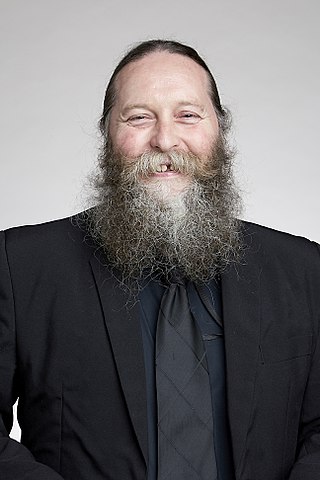
Pete Smith is Professor of Soils and Global change at the University of Aberdeen where he directs the Scottish Climate Change Centre of Expertise, ClimateXChange.
Renee Elizabeth Sockett is a professor and microbiologist in the School of Life Sciences at the University of Nottingham. She is a world-leading expert on Bdellovibrio bacteriovorus, a species of predatory bacteria.
References
- 1 2 Anon (2018). "Hopper, Prof. Andrew" . Who's Who . Vol. 1998 (online Oxford University Press ed.). Oxford: A & C Black. doi:10.1093/ww/9780199540884.013.U20751.(Subscription or UK public library membership required.)
- ↑ Alison Gail Smith publications from Europe PubMed Central
- 1 2 Smith, Alison (2016). "Alison Smith CV" (PDF). University of Cambridge. Archived from the original (PDF) on 26 June 2022.
- 1 2 3 Anon (2015). "Plant Metabolism at the University of Cambridge". University of Cambridge.
- ↑ Scott, Stuart A; Davey, Matthew P; Dennis, John S; Horst, Irmtraud; Howe, Christopher J; Lea-Smith, David J; Smith, Alison G (2010). "Biodiesel from algae: challenges and prospects". Current Opinion in Biotechnology . 21 (3): 277–286. doi:10.1016/j.copbio.2010.03.005. PMID 20399634.
- ↑ Croft, Martin T.; Lawrence, Andrew D.; Raux-Deery, Evelyne; Warren, Martin J.; Smith, Alison G. (2005). "Algae acquire vitamin B12 through a symbiotic relationship with bacteria". Nature . 438 (7064): 90–93. Bibcode:2005Natur.438...90C. doi:10.1038/nature04056. PMID 16267554. S2CID 4328049.
- ↑ Stephenson, Anna L.; Kazamia, Elena; Dennis, John S.; Howe, Christopher J.; Scott, Stuart A.; Smith, Alison G. (2010). "Life-Cycle Assessment of Potential Algal Biodiesel Production in the United Kingdom: A Comparison of Raceways and Air-Lift Tubular Bioreactors". Energy & Fuels . 24 (7): 4062–4077. doi:10.1021/ef1003123.
- ↑ Ciulli, Alessio; Williams, Glyn; Smith, Alison G.; Blundell, Tom L.; Abell, Chris (2006). "Probing Hot Spots at Protein−Ligand Binding Sites: A Fragment-Based Approach Using Biophysical Methods". Journal of Medicinal Chemistry . 49 (16): 4992–5000. doi:10.1021/jm060490r. PMID 16884311.
- ↑ Alison Gail Smith's ORCID 0000-0001-6511-5704
- ↑ Smith, Alison Gail (1981). Chlorosis induction in haloblight disease of bean: a biochemical study. ulmss-newton.lib.cam.ac.uk (PhD thesis). University of Cambridge.
- ↑ Alison Gail Smith's publications indexed by the Scopus bibliographic database. (subscription required)
- Alison Gail Smith publications indexed by Google Scholar - ↑ Grant, Matthew AA; Kazamia, Elena; Cicuta, Pietro; Smith, Alison G (2014). "Direct exchange of vitamin B12 is demonstrated by modelling the growth dynamics of algal–bacterial cocultures". The ISME Journal . 8 (7): 1418–1427. Bibcode:2014ISMEJ...8.1418G. doi:10.1038/ismej.2014.9. PMC 4069406 . PMID 24522262.
- Davey, M. P.; Horst, I.; Duong, G.-H.; Tomsett, E. V.; Litvinenko, A. C. P.; Howe, C. J.; Smith, A. G. (2014). "Triacylglyceride Production and Autophagous Responses in Chlamydomonas reinhardtii Depend on Resource Allocation and Carbon Source". Eukaryotic Cell . 13 (3): 392–400. doi:10.1128/EC.00178-13. PMC 3957581 . PMID 24413660.
- Kazamia, Elena; Aldridge, David C.; Smith, Alison G. (2012). "Synthetic ecology – A way forward for sustainable algal biofuel production?". Journal of Biotechnology . 162 (1): 163–169. doi:10.1016/j.jbiotec.2012.03.022. - ↑ Ghosh, Pallab (2016). "UK scientists speak about Brexit pain". London: BBC. Archived from the original on 21 July 2016.
- ↑ Anon (2016). "UK government grants awarded to Alison Gail Smith". gtr.rcuk.ac.uk. Swindon: Research Councils UK. Archived from the original on 26 January 2017.
- ↑ Moulin, M.; McCormac, A. C.; Terry, M. J.; Smith, A. G. (2008). "Tetrapyrrole profiling in Arabidopsis seedlings reveals that retrograde plastid nuclear signaling is not due to Mg-protoporphyrin IX accumulation". Proceedings of the National Academy of Sciences . 105 (39): 15178–15183. Bibcode:2008PNAS..10515178M. doi: 10.1073/pnas.0803054105 . PMC 2567511 . PMID 18818314.

- ↑ Al-Khalili, Jim (2017). "Alison Smith on algae". London: BBC.
Alison Smith, Professor of Plant Sciences at the University of Cambridge, is a world expert on algae, which range in size from giant kelp to microscopic cyanobacteria. They are found all over the world from the Arctic to the Tropics, live in water and make energy from the sun by photosynthesis. She talks to Jim al-Khalili about their biology and their many uses, such as biofuels.
- ↑ Lean, Thomas (2010). "Professor Andy Hopper Interview" (PDF). sounds.bl.uk. London: British Library. Archived from the original (PDF) on 9 October 2012.